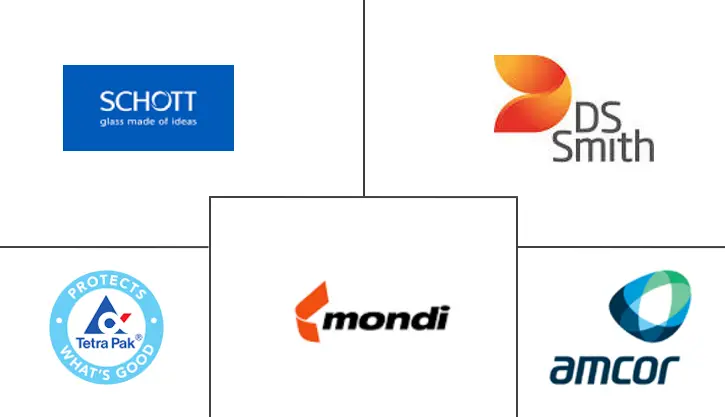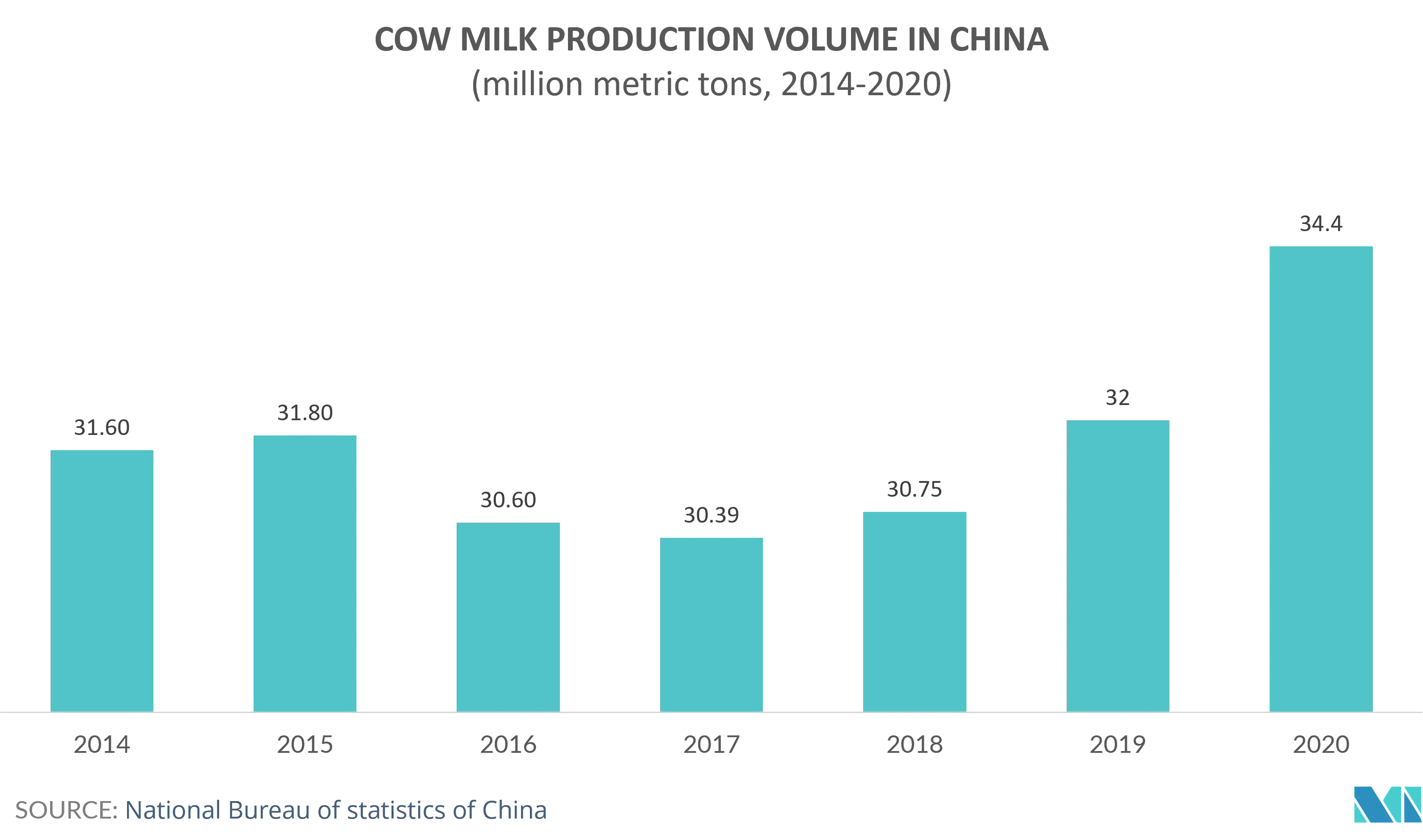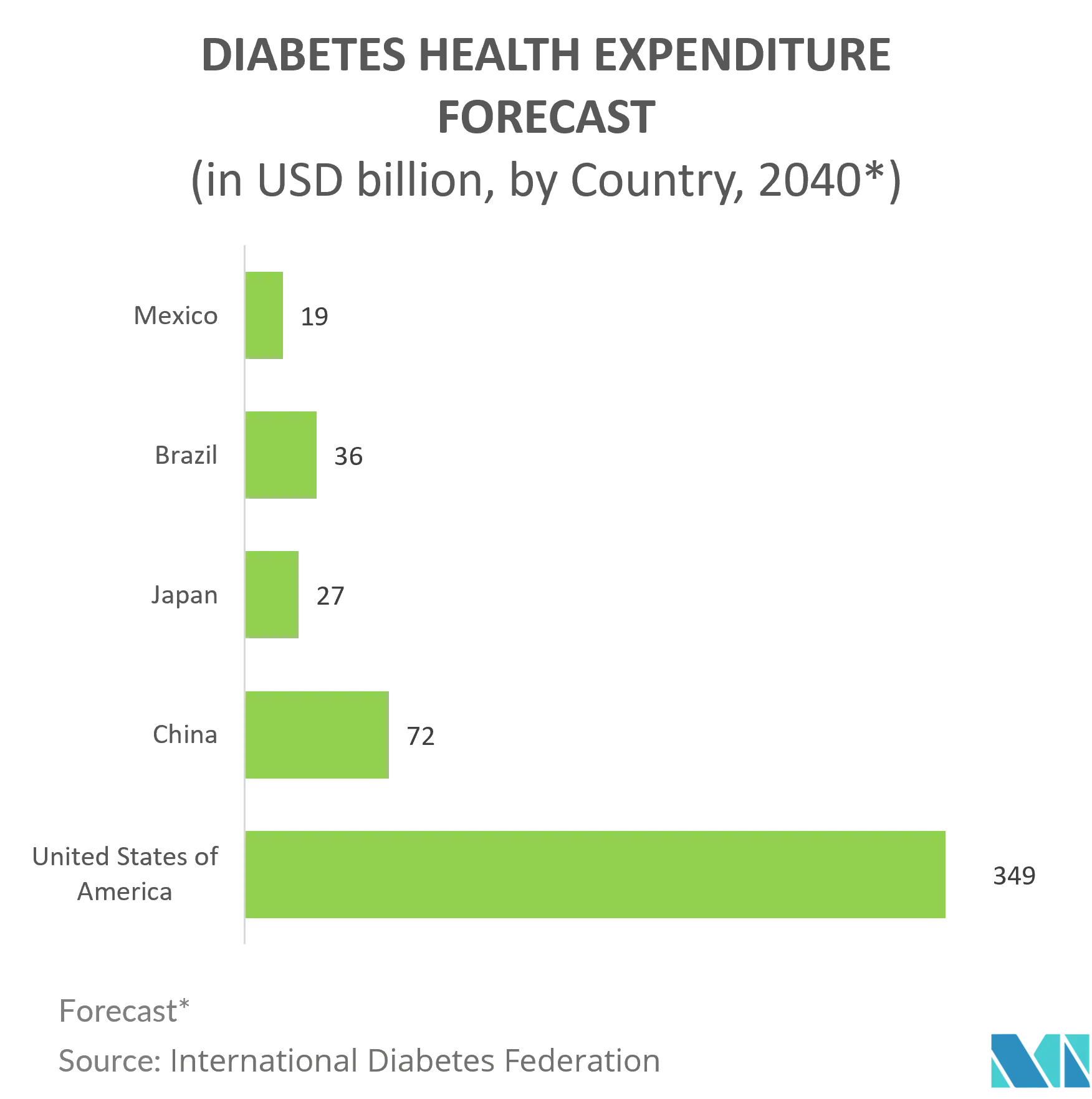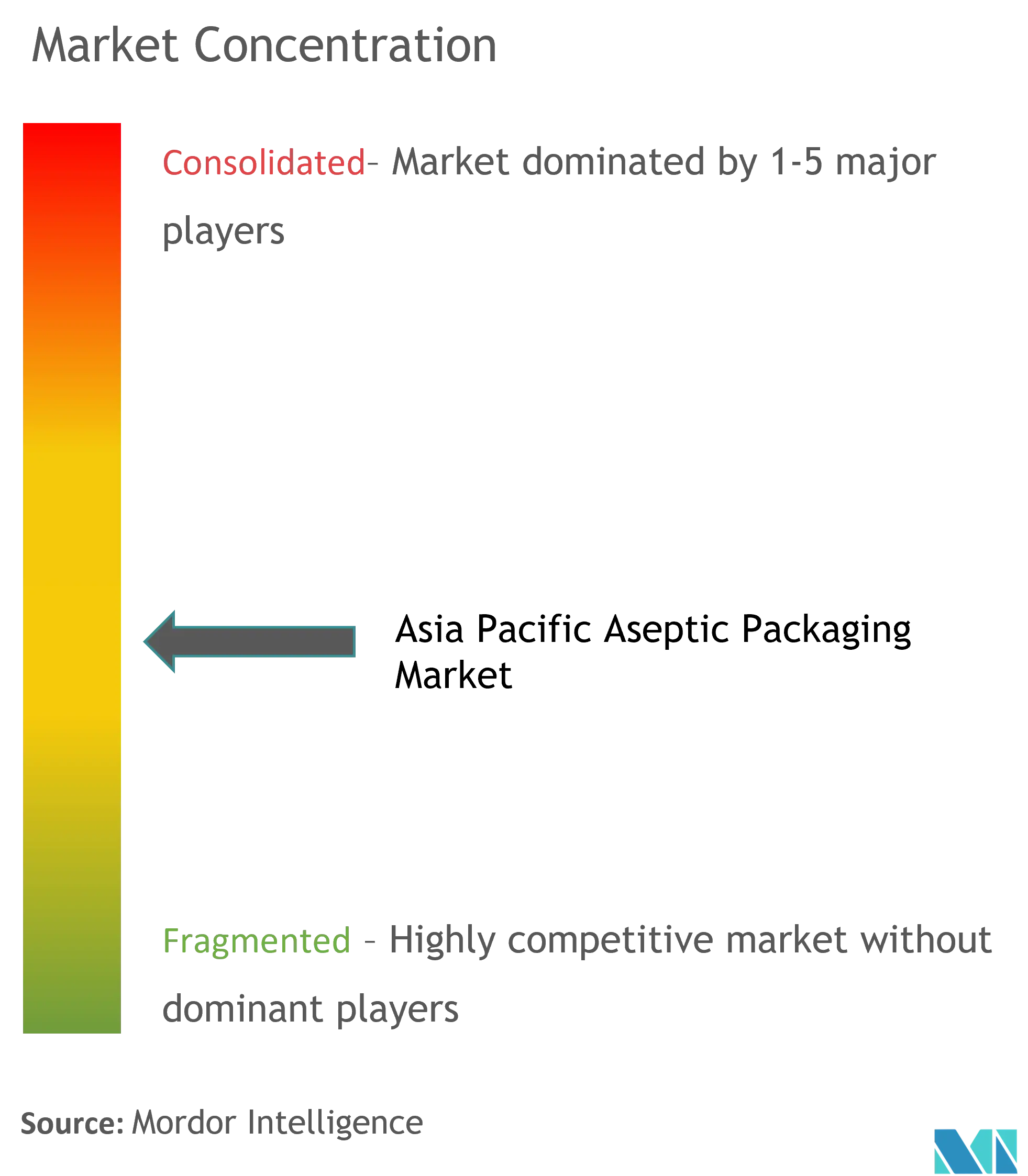APAC Aseptic Packaging Market Size

| Study Period | 2019 - 2029 |
| Base Year For Estimation | 2023 |
| Market Size (2024) | USD 30.22 Billion |
| Market Size (2029) | USD 50.73 Billion |
| CAGR (2024 - 2029) | 10.91 % |
| Market Concentration | Medium |
Major Players
*Disclaimer: Major Players sorted in no particular order |
APAC Aseptic Packaging Market Analysis
The APAC Aseptic Packaging Market size is estimated at USD 30.22 billion in 2024, and is expected to reach USD 50.73 billion by 2029, growing at a CAGR of 10.91% during the forecast period (2024-2029).
The Asian region has been one of the leading markets for aseptic packaging products and equipment, owing to the dominance of local companies in the aseptic packaging industry. Although the market volumes have been static in most of the areas in the region, however, growing innovations are expected to expand the industrial applications.
- The rapidly increasing demand from the pharmaceutical industry and the food and beverage industry are some of the factors expected to drive the demand for aseptic packaging in the region.
- In the case of the food and beverage industry, sustainable packaging and longer shelf life are of great importance to the consumer. As a result, most of the food and beverage vendors operating in the region are inclining towards aseptic packaging, along with cost and environmental benefits in considerations, especially in terms of ambient shipping and storage.
- Also, as aseptic packaging supports packaging through recyclable cartons and eco-friendly pouches and bags that often target consumers that prefer small quantity packaging and make purchases more frequently, the demand for such products is considerably high in the region.
- In the case of the food industry, increasing smart and active packaging initiatives that provide both shelf-stability and after-sale advantages are expected to become packaging standards in the region, especially in Asia. Also, the expanding applications in liquid, low particulate, and pumpable foods that are often replacing metal cans and glass jars are anticipated to drive the demand for lightweight, flexible and paper-based variants of the aseptic packaging in the region.
- Owing to the spread of COVID-19, the market is expected to witness significant growth. Due to the pandemic, customers have shifted towards online retail as well as panic stocking, which led to an increased demand for essential food items such as milk, baby food, and vegetables.
- Moreover, the concerns regarding food hygiene due to Covid-19 have been increasing the demand for aseptic packaging. In the coming years, the customers are expected to prefer better packaging to prevent themselves from such diseases, which would compel the vendors to think on the lines of sustainable aseptic packaging.
APAC Aseptic Packaging Market Trends
This section covers the major market trends shaping the APAC Aseptic Packaging Market according to our research experts:
Increasing Demand for Longer Shelf Life of Products
- Consumers have been demanding products with extended shelf life and easier usage. This has necessitated the companies to develop alternate packaging solutions. Shelf life has been an important aspect of the product. Companies looking to expand their product offerings with less dependency on sophisticated cold storage chains have become imperative to produce packages that provide longer shelf life.
- The shelf life can be increased by protecting the products from potential deteriorating agents, such as oxygen, moisture, and microbes. In order to protect their products, companies need a packaging solution that can achieve the same and is also cost-effective. Reducing wastage throughout the food supply chain is likely to become a crucial activity to reduce the environmental impact of agriculture and to serve the increasing food demand. Therefore, investing in efficient, low-cost, and sustainable processing and packaging solutions to increase the shelf life of products (especially dairy, baby food, and nutraceuticals) is a viable solution, thus augmenting the requirement of aseptic packaging.
- Changing lifestyles and the consequent dependence of consumers on processed, packaged, and precooked food is increasing the demand for aseptic packaging solutions. The advent of the supermarket culture has also altered the landscape of shopping and has increased the need for packaging, especially in food and beverage products. The altering lifestyle of people has resulted in the shift from home-cooked to ready-to-eat products. In addition to this ease of use, these products should also be packaged in such a way to ensure they are fresh and uncontaminated.
- Food packaging has no longer just a passive role in protecting and marketing a food product. The emphasis on the decrease of the use of preservatives is also a driving factor for the use of aseptic packaging as aseptic food preservation methods enable processed food to be kept for a longer period of time without preservatives as long as they are not opened.
- Moreover, with the growing population in the region, the production of milk is increasing as cow milk is a part of the daily diet. For instance, according to the National Bureau of Statistics of China, cow milk production in China for the year 2020 accounted for 34.4 million metric tons compared to 32.01 metric tons in 2019. This demands a longer shelf life of up to 6 months, and aseptic packaging is of high use as the packaging is sterilized prior to the fillion with UHT-treated milk.

Pharmaceutical sector is expected to higher witness growth during the forecast
- Prefillable syringes overcome disadvantages of parenteral drug delivery, such as lack of convenience, affordability, accuracy, sterility, and safety. These syringes enable easy management of chronic diseases, such as Diabetes and Rheumatoid Arthritis, which is expected to boost the use of auto-injectors and pen injectors over the forecast period. Thus, the growing prevalence of Diabetes and other chronic diseases in the Asian region is expected to fuel the market demand over the forecast period.
- Prefilled syringes are emerging as one of the fastest-growing choices for unit dose medication as the pharmaceutical industry seeks new and more convenient drug delivery methods. Also, Pharmaceutical companies are minimizing drug waste and increasing product life span, while patients are able to self-administer injectable drugs at their homes instead of the hospital.
- According to International Diabetes Federation, 114 million cases of Diabetes were recorded in China in 2020 and states that health expenditure based on DiabetesDiabetes in the country would increase to USD 72 billion by 2040. Thus, increasing insulin market growth is expected to drive the prefillable syringes market that would further aid the growth of the Aseptic Packaging Market.
- Around 80% of the vials and ampoules are made from glass, owing to their suitability with varied drug combinations, but they face challenges like delamination, breakage, etc. Alternative plastic vials, like Cycle Olefin Polymer (COP) and Cycle Olefin Co-Polymer (COC) formats, are likely to gain significant market share over the next five years. Major players, such as Schott and Gerresheimer, possess experience in COC for pharmaceutical applications. Such developments are driving the need for aseptic packaging in the region.
- Furthermore, the use of innovative technologies in ampoules, such as radio frequency identification tags (RFID), deployed with a seal applied outside the packaging, is growing owing to the potential to provide individual security throughout supply chains. All these are expected to drive the aseptic packaging market in the vials and ampoules segment in the region.

APAC Aseptic Packaging Industry Overview
The Asia Pacific Aseptic Packaging Market is highly competitive as there are multiple vendors operating in the domestic and international markets. The market appears to be moderately concentrated, with the players adopting various strategies such as product innovation, mergers, and acquisitions, among others, primarily to expand their reach and stay competitive in the market. Some of the major players in the market are Schott AG, DS Smith Plc, Tetra Pak International, among others.
- August 2021- SIG announced the completion of the second production plant of aseptic packaging in china. The plant is expected to reach an annual production capacity of eight billion aseptic carton packs by 2024. Further, the plant includes printing, creasing, cutting, extrusion, and sealing capabilities to customize products according to preference.
- November 2021 - Greatview Aseptic Packaging Operations in china was fully certified by ASI for their Aluminium stewardship. This enables the company to attract more customers in the Asian region and grow in the market, attracting a lot of food and beverage vendors in the region.
APAC Aseptic Packaging Market Leaders
-
Amcor plc
-
Schott AG
-
DS SMITH PLC
-
Mondi PLC
-
Tetra Pak International SA
*Disclaimer: Major Players sorted in no particular order

APAC Aseptic Packaging Market News
- November 2021- UFlex announced to double the capacity of a liquid packaging plant in India. The plant is located in Gujarat and aims to increase production capacity from 3.5 billion to 7 billion packs per annum. Also, the company expects to complete it within ten months. The expansion, according to the company, is in response to new contracts and increasing demand for the aseptic packaging laminates in the region.
APAC Aseptic Packaging Market Report - Table of Contents
1. INTRODUCTION
- 1.1 Study Assumptions and Market Definition
- 1.2 Scope of the Study
2. RESEARCH METHODOLOGY
3. EXECUTIVE SUMMARY
4. MARKET DYNAMICS
- 4.1 Market Overview
- 4.2 Industry Value Chain Analysis
-
4.3 Industry Attractiveness - Porter's Five Forces Analysis
- 4.3.1 Bargaining Power of Suppliers
- 4.3.2 Bargaining Power of Buyers
- 4.3.3 Threat of New Entrants
- 4.3.4 Threat of Substitute Products
- 4.3.5 Intensity of Competitive Rivalry
- 4.4 Opportunities in the Asia Pacific Aseptic packaging market
- 4.5 Assessment of COVID-19 impact on the industry
- 4.6 Technology Snapshot
5. MARKET DYNAMICS
-
5.1 Market Drivers
- 5.1.1 Increasing Demand to Reduce Cost of Cold Chain Logistics
- 5.1.2 Increasing Demand for Longer Shelf Life of Products
-
5.2 Market Challenges
- 5.2.1 Concerns over Environment and Recycling
- 5.2.2 Manufacturing Complications( for example increasing cost of raw materials) & Lower ROI
6. MARKET SEGMENTATION
-
6.1 Packaging Material
- 6.1.1 Metal
- 6.1.2 Glass
- 6.1.3 Paper
- 6.1.4 Plastics
- 6.1.5 Others
-
6.2 Packaging Type
- 6.2.1 Carton Boxes
- 6.2.2 Bags and Pouches
- 6.2.3 Cups and Trays
- 6.2.4 Bottles and Jars
- 6.2.5 Metal Cans
- 6.2.6 Plastic Cans
- 6.2.7 Composite Cans
- 6.2.8 Others
-
6.3 Geography
- 6.3.1 China
- 6.3.2 India
- 6.3.3 South Korea
- 6.3.4 Japan
- 6.3.5 Rest of Asia Pacific
-
6.4 End-User Industry
- 6.4.1 Food
- 6.4.2 Beverage
- 6.4.3 Pharmaceutical & Medical
- 6.4.4 Others
7. COMPETITIVE LANDSCAPE
-
7.1 Company Profiles
- 7.1.1 Tetra Pak International SA
- 7.1.2 Amcor PLC
- 7.1.3 Schott AG
- 7.1.4 Ecolean Packaging
- 7.1.5 Reynolds Group Holdings
- 7.1.6 SIG Combibloc Group
- 7.1.7 WESTROCK COMPANY
- 7.1.8 DS SMITH PLC
- 7.1.9 Mondi PLC
- 7.1.10 Krones, Inc.
- 7.1.11 Greatview Aseptic Packaging
- 7.1.12 Sealed Air Corporation
- 7.1.13 Coesia S.P.A.
- 7.1.14 CFT S.P.A.
- *List Not Exhaustive
8. Investment Analysis
9. Future of the Asia Aseptic Packaging Market
** Subject To AvailablityAPAC Aseptic Packaging Industry Segmentation
Aseptic packaging is a technique that is being used for the preservation of liquid and other particulate foods. The sterilization of food packaging materials and food contact surfaces is very crucial in the aseptic packaging system. In this process, the food is sterilized outside the primary container and then is placed in a previously sterilized container which is then sealed in an aseptic environment.
| Packaging Material | Metal |
| Glass | |
| Paper | |
| Plastics | |
| Others | |
| Packaging Type | Carton Boxes |
| Bags and Pouches | |
| Cups and Trays | |
| Bottles and Jars | |
| Metal Cans | |
| Plastic Cans | |
| Composite Cans | |
| Others | |
| Geography | China |
| India | |
| South Korea | |
| Japan | |
| Rest of Asia Pacific | |
| End-User Industry | Food |
| Beverage | |
| Pharmaceutical & Medical | |
| Others |
APAC Aseptic Packaging Market Research FAQs
How big is the APAC Aseptic Packaging Market?
The APAC Aseptic Packaging Market size is expected to reach USD 30.22 billion in 2024 and grow at a CAGR of 10.91% to reach USD 50.73 billion by 2029.
What is the current APAC Aseptic Packaging Market size?
In 2024, the APAC Aseptic Packaging Market size is expected to reach USD 30.22 billion.
Who are the key players in APAC Aseptic Packaging Market?
Amcor plc, Schott AG, DS SMITH PLC, Mondi PLC and Tetra Pak International SA are the major companies operating in the APAC Aseptic Packaging Market.
What years does this APAC Aseptic Packaging Market cover, and what was the market size in 2023?
In 2023, the APAC Aseptic Packaging Market size was estimated at USD 27.25 billion. The report covers the APAC Aseptic Packaging Market historical market size for years: 2019, 2020, 2021, 2022 and 2023. The report also forecasts the APAC Aseptic Packaging Market size for years: 2024, 2025, 2026, 2027, 2028 and 2029.
APAC Aseptic Packaging Industry Report
Statistics for the 2024 APAC Aseptic Packaging market share, size and revenue growth rate, created by Mordor Intelligence™ Industry Reports. APAC Aseptic Packaging analysis includes a market forecast outlook to 2029 and historical overview. Get a sample of this industry analysis as a free report PDF download.



